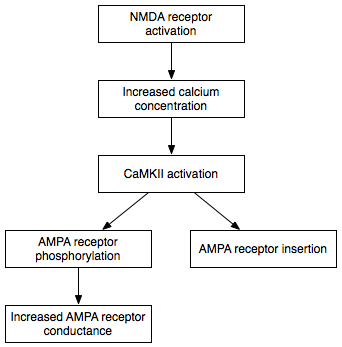Why are 'racetams synergistic though?
Let's go back to the original mechanism of action we are trying to optimize here: Long Term Potentiation!
http://en.wikipedia....rm_potentiation
Induction
Late LTP is induced by changes in gene expression and protein synthesis brought about by the persistent activation of protein kinases activated during E-LTP, such as MAPK.[25][24][30] In fact, MAPK—specifically the extracellular signal-regulated kinase (ERK) subfamily of MAPKs—may be the molecular link between E-LTP and L-LTP, since many signaling cascades involved in E-LTP, including CaMKII and PKC, can converge on ERK.[30] Recent research has shown that the induction of L-LTP can depend on coincident molecular events, namely PKA activation and calcium influx, that converge on CRTC1 (TORC1), a potent transcriptional coactivator for cAMP response element binding protein (CREB).[31] This requirement for a molecular coincidence accounts perfectly for the associative nature of LTP, and, presumably, for that of learning.
Delving into the role of CREB in LTP and cognition we find:
http://en.wikipedia....lular_Cognition
There is a great deal of evidence to suggest that CREB has a role in the molecular steps that stabilize memory in the brain. This evidence includes CREB manipulations in several learning paradigms across multiple brain regions and multiple species. For example, there is compelling evidence showing that CREB has a role in emotional memory. This form of memory can be studied in rodents with experimental paradigms that depend on fear conditioning, an amygdala-dependent behavior. The evidence that supports a role for CREB in emotional memory falls into three experimental categories: negative manipulations (where the levels of CREB were lowered), positive manipulations (where the levels of CREB were increased), and non-interventions (where the endogenous levels of CREB were tracked before and after learning).
So CREB and thus late LTP is what CILTEP works on. By activating CREB via increased cAMP, this link in the chain works better for encoding long term memory (>3 hours).
Dopamine also enhanced the cAMP/CREB pathway
Similarly, activation ofdopamine receptors may enhance LTP through the cAMP/PKA signaling pathway.[44][45]
Now what are the 'racetams good for here?
They are good for Early LTP ( Short Term Memory). Notice that CREB does not enhance short-term memory, only long-term!
Electrophysiological studies in Aplysia indicated that decreasing CREB function blocks long, but not short-term changes in synaptic function [1]. Changes in synaptic function (i.e., synaptic plasticity) are required for learning and memory [2] As evidence of this, a line of mice with a targeted disruption of the α and δ isoforms of CREB showed intact short-term memory, but disrupted long-term memory in several behavioral tasks, including contextual conditioning and spatial learning in the water maze, two hippocampal-dependent learning tasks.
So what's going on in short-term memory land?

Well for NMDA receptor activation there's Magnesium Threonate to sensitize and upregulate NMDA receptors (http://www.ncbi.nlm....pubmed/20152124).
Then for AMPA Receptors, there's the 'racetams, which positively modulate AMPA receptor activation (http://www.ncbi.nlm....pubmed/20163115). Your brain is like a big chemical factory with multiple workstations that process different chemicals into other chemicals and use all sorts of very messy complicated signal transduction mechanism to produce memories. What we are doing here is optimizing or increasing the capacity of the workstations. All this is done delicately without over stressing the machinery.
The ultimate nootropic is not a single pill. That's because the brain does not have a single chemical mechanism for intelligence. It's only in understanding each piece of machinery in the brain that one can perform synergistic optimization.
Edited by abelard lindsay, 20 May 2012 - 07:29 PM.



















































